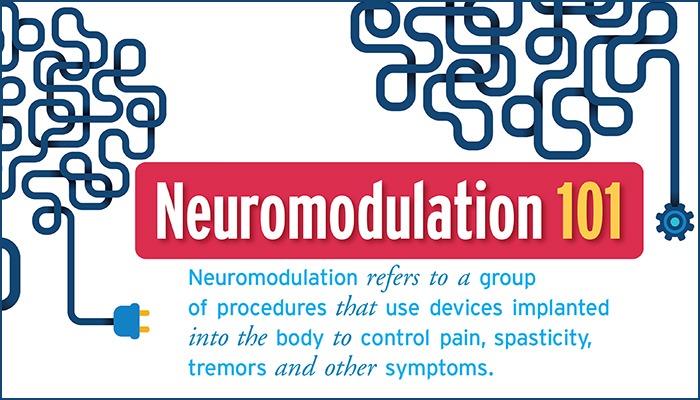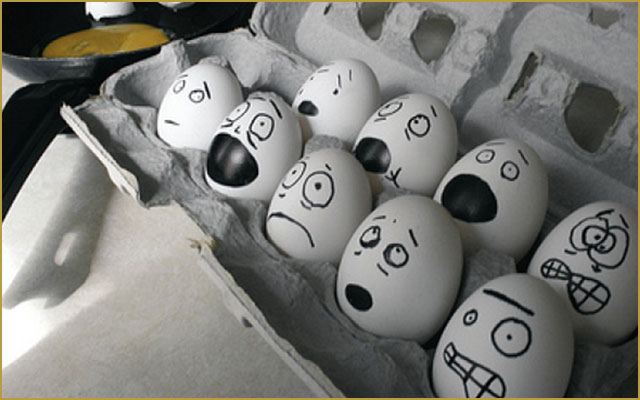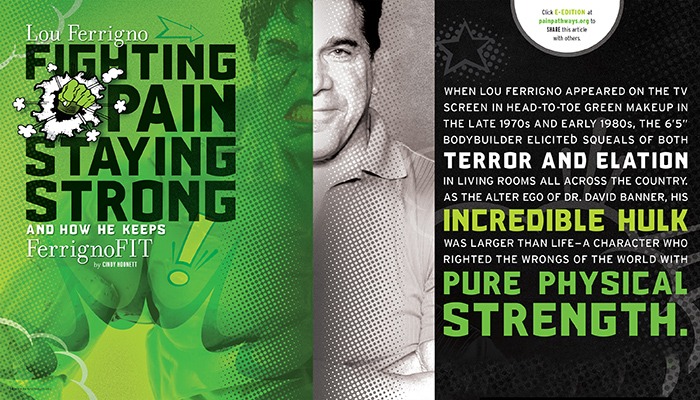Neuromodulation 101

This article on neuromodulation was provided by the North American Neuromodulation Society (NANS). To learn more, please visit: www.neuromodulation.org
Used to manage a variety of recalcitrant pain syndromes, neuromodulation encompasses the application of targeted electrical, chemical and biological technologies to the nervous system in order to improve function and quality of life.
The appropriate neuromodulation therapy (low-level electrical pulses or precise doses of medicine) is targeted to nerves or the spinal cord to alter pain signals to the brain. The technology used to transmit the electrical pulses in neuromodulation is similar to that used in pacemakers for treating patients with certain heart conditions. In fact, the battery generator for neuromodulation devices is similar in appearance to a pacemaker. People who have received neuromodulation treatments have often been able to resume more normal lives filled with routine daily activities including work.
While there are two broad classes of neuromodulation devices, those that provide relief through electrical stimulation and those that provide relief through drug delivery into the central nervous system, this issue of PainPathways is dedicated to devices used to treat pain through electrical stimulation.
3 KEY AREAS OF STIMULATION
These include electrical stimulation of the spinal cord (spinal cord stimulation, or SCS), the brain (deep brain stimulation, or DBS) and peripheral nerve stimulation (PNS). With each option, electrical stimulation is applied to nervous structures. PNS can encompass a wide range of treatment targets.
SPINAL CORD STIMULATION
Spinal cord stimulation, or SCS therapy, involves the application of micro-currents of electricity to specific regions of the spinal cord to change the perception of pain. The most common use of SCS in North America is to treat pain. However, in Europe these devices are also commonly used to manage conditions that result in insufficient blood flow, usually in the legs, but also in the heart. In selected cases, spinal cord stimulation can be remarkably effective at relieving pain and improving functional capacity.
SCS produces a sensation of tingling in the painful area of the body that changes the way pain is perceived by the patient. SCS changes or alters the perception of pain at the level of the central nervous system (brain and spinal cord) by altering underlying neural pathways and changing how the brain perceives/processes painful stimuli.
There are other electrical stimulating devices such as TENS (transcutaneous electrical nerve stimulation), but SCS affects pain pathways differently. Studies show that there is no meaningful correlation between whether TENS helps or not and the effectiveness of SCS.
SCS and PNS were developed to treat neuropathic (nerve) pain, typically associated with injury to nerves, and described by patients as a burning, shooting or tingling pain. It may be associated with other neurologic changes like painful numbness or a greatly increased sensitivity to things that wouldn’t normally produce pain, such as a light touch. For example, back surgery can cause irreversible damage to nerves, causing chronic lower extremity pain. Diabetes is another example of a condition that can attack nerves in the arms and legs and produce a severe burning or tingling sensation that might be associated with numbness and pain. Neuropathic pain typically does not respond well to narcotic pain medications, and many of the agents that can be effective can cause side effects or other problems.
FIRST, A TRIAL
Although some physicians advocate early use of this modality, most attempt a more conservative treatment approach and only turn to SCS if those methods fail to achieve adequate relief. Medicare and most major insurers require a psychological evaluation to screen for conditions that can limit this therapy’s effectiveness. Atrial is performed before the permanent neuromodulation device is inserted and typically lasts three to seven days. For the trial, the doctor places wires (referred to as leads) through a needle into the epidural space and steers these to lie over the specific areas of the spinal cord that correlate with the distribution of pain.
During the trialing procedure, recipients must be aware enough to answer questions about whether and where stimulation is felt. The doctor will try to position the leads in a location that provides a tingling sensation overlying the painful areas. Once a good location is identified, the needle is removed and leads are secured to the skin. A temporary external pulse generator (battery) will be attached to the end of the lead that’s outside of the body, and is programmed to provide stimulation (a soothing tingling sensation) to the areas of the body where pain is experienced.
There are typically eight different contact points on each lead and usually one or two leads are inserted for the trial, although this depends on the pattern of pain and its location. Since each of those contacts can be positive, negative or off, the doctor literally has thousands of combinations available to optimize the stimulation pattern. During the trial period the patient is asked to keep track of whether the stimulation relieves pain and to monitor its effect on their ability to perform normal activities of daily living. After the trial period the patient and physician jointly make a decision as to whether to have the device permanently implanted.
ADVANTAGES OF SCS, AND HOW IT WORKS
The SCS system consists of a programmable (and usually rechargeable) pulse generator (the battery) that generates a personalized stimulation pattern. The generator is connected under the skin to the leads that are placed in the spinal canal, as described above. Your “mileage” on the battery will be determined by how often you use it and how high the settings are. Replacing the battery means replacing the entire pace-maker-sized pulse generator. Rechargeable generators typically are recharged every 1-2 weeks by placing are charging device directly over the implanted battery and recharging through the skin.
The leads come in two types: those that can be placed through a needle (percutaneous leads) and those that are placed surgically (paddle leads). Paddle leads are more stable in terms of position and also more energy efficient, but are associated with the need for a larger surgical procedure to insert them with all the other associated risks and concerns. Both approaches have merits, and should be discussed with a physician.
SCS devices come with a remote to turn it on and off, and to adjust stimulation characteristics and patterns. Another advantage of SCS is that it uses low-level electrical stimulation instead of medications, avoiding many of the risks and related side effects that come with all medications. Many recipients find they can even eliminate their medications altogether.
PERIPHERAL NERVE/FIELD STIMULATION
Peripheral nerve stimulation (PNS) uses similar principles to SCS to treat pain but places the leads in an area located away from the actual spinal cord. This can be a nerve after it has exited the spinal cord but still at the spinal level, a nerve outside the spine (in the “periphery”), or just under the skin at the terminal ends of the nerve. By stimulating peripheral nerves we can also provide treatment of a variety of painful conditions that affect a discrete localized area. In peripheral nerve stimulation a lead is placed next to a nerve, and stimulation is applied directly to the nerve. With peripheral nerve field stimulation (PNFS), leads are placed subcutaneously (just under the skin) and the peripheral nerves are stimulated through the nerve endings. PNFS is a newer approach, and ongoing studies will help to elucidate its exact role. Examples of PNS/PNFS include occipital nerve stimulation for headaches, sacral nerve stimulation for pelvic pain and subcutaneous field stimulation of the abdominal wall for the treatment of post-herniorrhaphy pain.
OTHER NEUROMODULATION INDICATIONS
Neuromodulation devices are routinely used to treat a variety of conditions today including Parkinson’s disease (tremors), spasticity (multiple sclerosis or spinal cord injury), seizures, overactive bladder, neurogenic bladder, and a myriad of other conditions. Stimulation is also being investigated as a possible treatment for many other conditions such as diabetes, sleep apnea, depression and asthma.
HOW TO LEARN MORE
To learn more about neuromodulation and locate a qualified practitioner in your area who can determine if you may be a candidate for neuromoduation therapy, visit the North American Neuromodulation Society (NANS) at www.neuromodulation.org. NANS is the largest medical specialty society dedicated to neuromodulation in North America, including specialists from anesthesiology, rehabilitation, urology, neurosurgery, pain medicine and neurology. {PP}
PainPathways Magazine
PainPathways is the first, only and ultimate pain magazine. First published in spring 2008, PainPathways is the culmination of the vision of Richard L. Rauck, MD, to provide a shared resource for people living with and caring for others in pain. This quarterly resource not only provides in-depth information on current treatments, therapies and research studies but also connects people who live with pain, both personally and professionally.
View All By PainPathways






